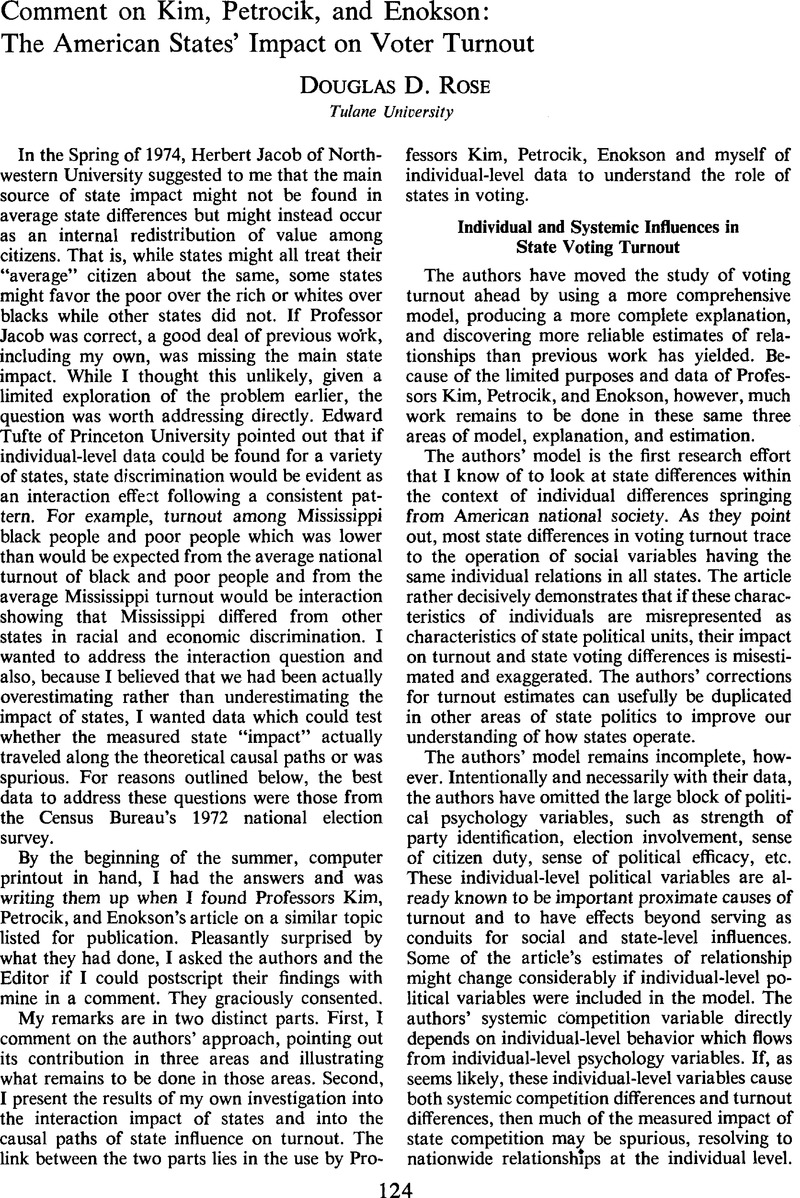Published online by Cambridge University Press: 01 August 2014

1 Bell, Roderick, “The State of the Texas Electorate: A Description and Interpretation of Who Texas Is,” prepared for the 68th Annual Meeting of the American Political Science Association (1972)Google Scholar, provides the coefficients for the text's percentages.
2 The Kim, Petrocik, and Enokson study accounts for individual-level turnout variance as well as or better than other well-known studies do. For instance, Shaffer, William R., in Computer Simulation of Voting Behavior (New York: Oxford University Press, 1972)Google Scholar, reports that the original Downsian model and the SRC six-components model perform fairly poorly in the 1964 election, accounting for only .1 per cent and 1.6 per cent, respectively, of the turnout variance. Riker, William and Ordeshook, Peter, in their “A Theory of the Calculus of Voting,” American Political Science Review, 62 (March, 1968), 25–42CrossRefGoogle Scholar, achieve a prediction of 11.6 per cent of individual turnout variance using four political variables (perceived closeness, care about outcome, duty, and specific election). Philip Converse, with the assistance of Richard Niemi, accounts for 19.7 per cent of the turnout variance using four background social variables (education, age, sex, and region) in “Non-Voting Among Young Adults in the United States,” in Political Parties and Political Behavior, ed. Crotty, William, Freeman, Donald and Gatlin, Douglas (Boston: Allyn and Bacon, 2nd ed., 1971)Google Scholar.
3 “Voting and Registration in the Election of November 1972,” Current Population Reports, Series P-20, No. 253 (October, 1973), Social and Economic Statistics Administration, Bureau of the Census, U.S. Department of Commerce, table 15Google Scholar.
4 Flanigan, William, Political Behavior of the American Electorate (Boston: Allyn and Bacon, 2nd ed., 1972), Table 1.1, p. 23Google Scholar.
5 “Voting and Registration in the Election of November 1972,” Current Population Reports, Tables 1, 3, 15.
6 Comparing survey and official tabulations always reveals discrepancies in turnout, and so it is here. A higher percentage of persons report voting than are reported voting in official tabulations. This does not appear to be a problem for the present study, as the between-state variance in turnout is close in both survey (variance is .00533) and official (variance is .00534) data. Additionally, state differences in the survey and the official reports are highly correlated (r = .958), so the differences in national average merely have the effect of reducing national variance, hence exaggerating the role of our variables in explaining turnout. Registration differences between survey and official data are more serious, as the public not only reports less registration than do state officials, but also the state publics report fewer state differences in registration (variance is .00306) than do the state officials' versions (variance is .00415). Moreover, the state differences from the two data sets are not close to perfect correlation (r = .816). I believe that the survey data provides the better index of registration of potential voters. The over-report of official data probably traces to the lag in striking the dead, institutionalized, and relocated citizens from the rolls; since states are believed to vary noticeably in the speed with which they correct their registration lists, the relation between the two sets of data is what would be expected if the survey were accurate. The combination of higher reported voting and lower reported registration in the survey as compared to official tabulations leads to considerable differences between the two in the proportion of registered voters going to the polls. Again, from the above it seems likely that the survey is more accurate.
7 Before starting estimation, one further operation was performed: state and age were made independent by setting the same age structure in each state. The authors have already pointed out the impact age has on state data, so it seemed wise to simplify analysis. The adjustment has little effect on the relevant correlations. (Data available on request.)
8 The only nonrandom patterns—and they are small—involve a slight inverse relation between registration rates and turnout among the registered: in Indiana, Missouri, and Texas, stiff registration procedures mean lower registration but higher turnout among the registered in the extreme age groups, while lax registration laws mean higher registration but lower turnout among the registered for susceptible age groups. Aside from this minor plausible pattern, interaction does not appear to have a real impact on voting.
Comments
No Comments have been published for this article.